Five Growth Principles For Business-to-Business Advertisers From Binet And Field, The Godfathers of Marketing Effectiveness
Les Binet, Head of Effectiveness at adam&eveDDB, and Peter Field, acclaimed marketing specialist, have been dubbed the “godfathers of marketing effectiveness” and have produced the world’s most authoritative analysis of how to grow revenue and profits.
Binet and Field studied the Institute of Practitioners in Advertising (the IPA) Databank of business-to-business (B2B) case studies from 1998-2018 to determine effective marketing strategies for B2B brands. Through this analysis, they developed their five principles of growth for B2B advertisers based on strategies and lessons learned in the business-to-consumer (B2C) realm.
1. Invest in share of voice: To grow, insure your share of voice is greater than your market share
To understand how to budget properly, B2B brands need to understand the share of voice rule, an equation that can predict brand growth, declines, or stability. Share of voice is the brand ad spend divided by category ad spend.
Share of voice is compared to share of market. Share of market is a brand or retailer’s revenue divided by category sales.
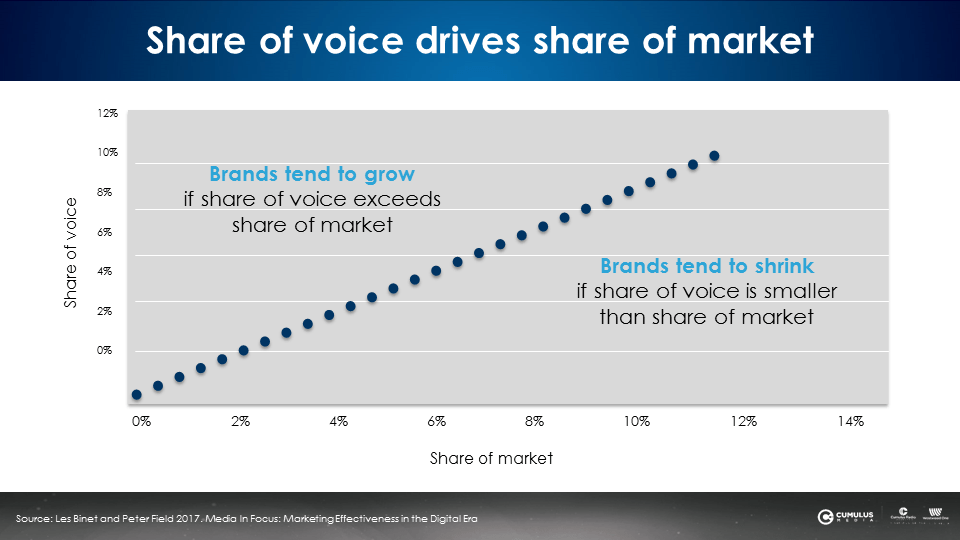
- If share of voice exceeds share of market, brands tend to grow.
- If share of voice is similar to share of market, brands tend to be stable.
- If share of voice is smaller than share of market, brands tend to shrink.
Binet and Field state that the share of voice rule has held for B2C advertisers for 50+ years and in their latest report, The 5 Principles Of Growth in B2B Marketing from the B2B Institute, they assert, “B2B brands appear to respond to share of voice in almost exactly the same way as B2C brands do.” To grow, a brand’s share of voice must exceed share of market.
2. Balance brand and activation: 62% branding, 38% sales activation
There are two types of campaigns: brand building and sales activation. Binet and Field show how sales activation campaigns (the grey line below) generate sales uplift through a series of short-term sales spikes that quickly collapse. Sales activation campaigns decay fast and don’t build long-term sales. They are the “carbs of advertising,” a sugar rush of short-term sales and then a crash.
Brand building ads (indicated by the blue line) are the “protein of advertising.” Of the two types of campaigns, brand building is harder to achieve, requires a greater investment, and is more important. According to Binet and Field, “Brand building means creating mental structures (associations, memories, beliefs, etc.) that will pre-dispose potential customers to choose one brand over another. This is a long-term job involving conditioning consumers…so it takes time; talking to people long before they come to buy.”
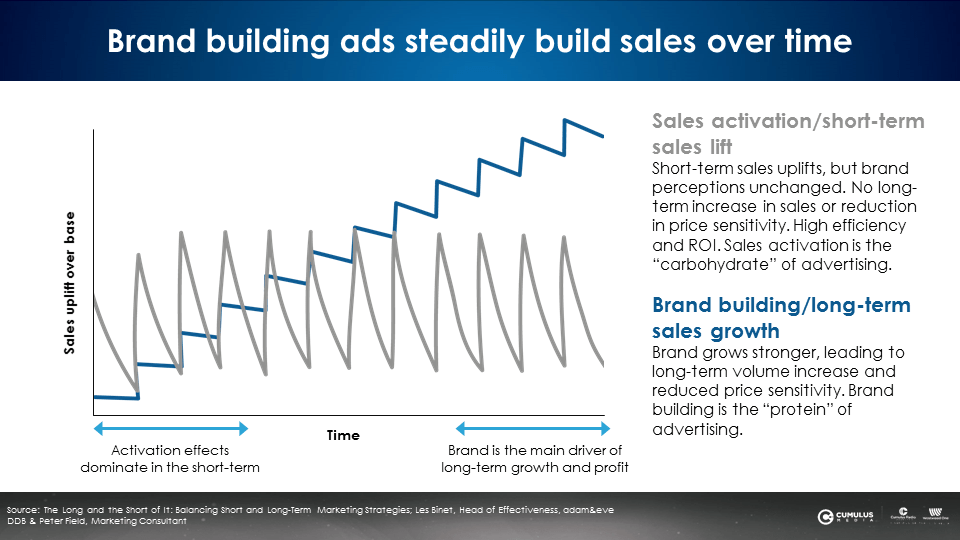
For B2B advertisers, brand building ads work harder than sales activation ads. According to the Binet and Field analysis of IPA B2B cases, the number of very large business effects reported for brand building ads (1.2) was higher than the effects reported from activation ads (0.7).
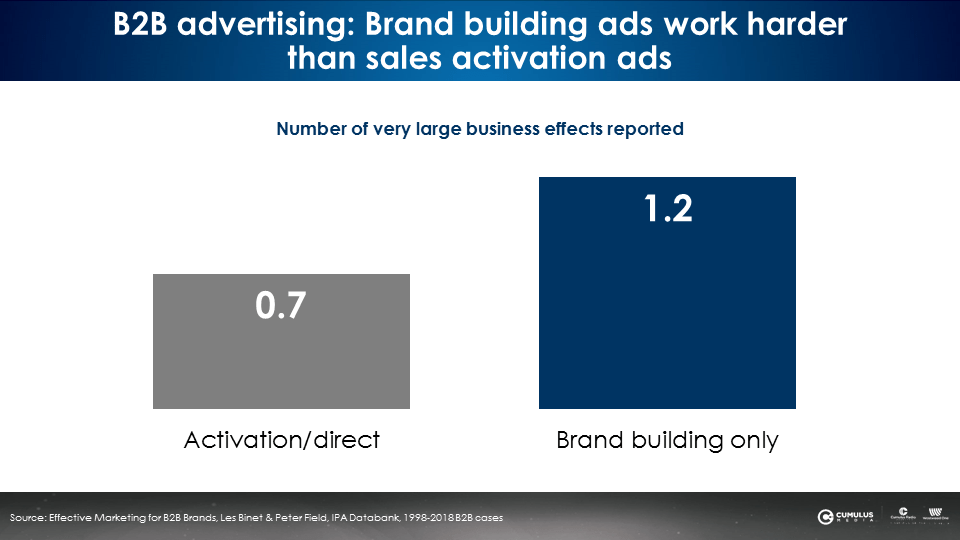
B2B brands that want to grow need to also be cognizant of the changes in activation versus branding ads as they mature. In the first year, activation ads (65%) should outweigh branding ads (35%) for optimal impact.
As B2B brands mature and become leaders in the market, the share shifts. Only 28% of the budget should go to activation ads while a much larger 72% should be put to branding ads.
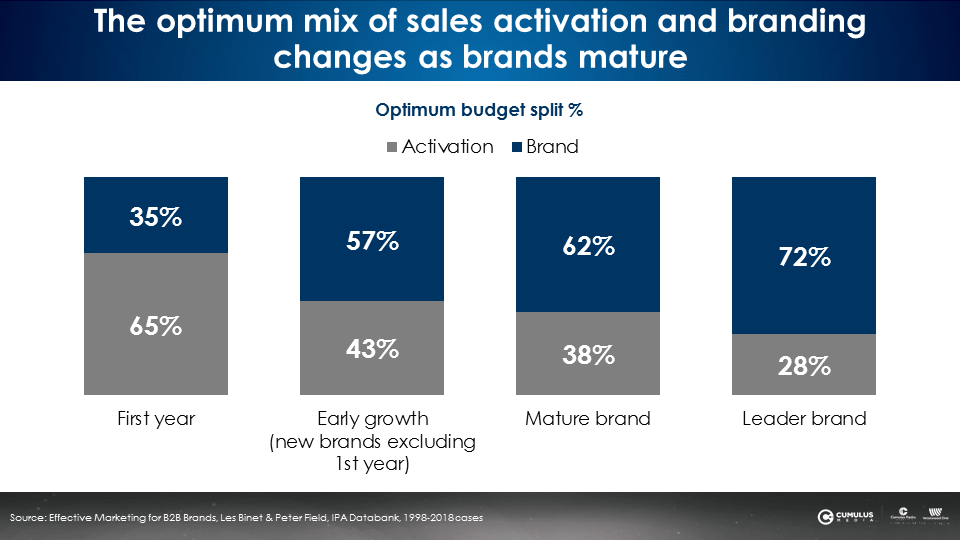
Budgets need to be adjusted to best fit the strategy of B2B marketing and variations exist between different sized corporations. On average, 38% of the budget should go to activation ads while 62% should go to branding.
As brands grow and become leaders, they begin to see higher budgets for their campaigns. In those instances, 36% of the budget should go to activation ads while a higher 64% should be relegated to branding ads.
Premium brands don’t need to promote using activation ads as much because they have already achieved strong awareness through years of advertising. At that stage in their company’s maturity, developing the brand is more important for impact.
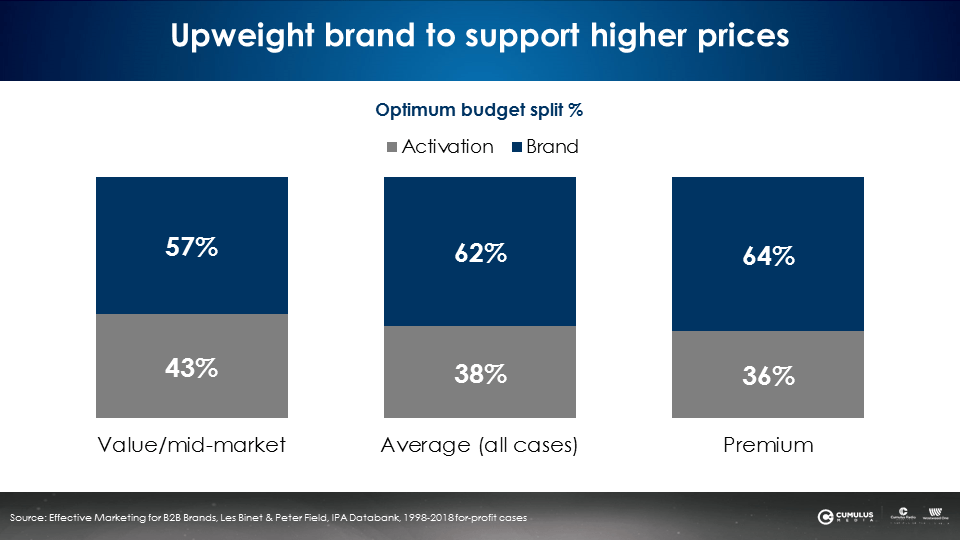
3. Expand the customer base with mass reach media
There are three business models for B2B brands: retaining existing customers through a loyalty strategy, acquiring new customers, and a broad reach strategy that looks to target all customers in the category whether existing or new.
Of these three groups, business effects reported were most significant among those reached by the broad reach strategy. For B2B brands, reaching the greatest number of potential customers yields the greatest results.
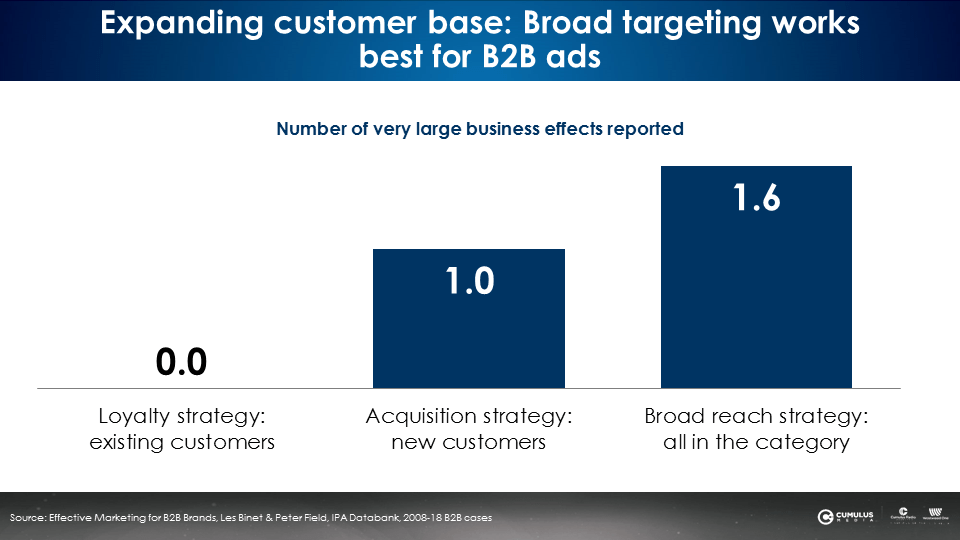
That’s why mass reach media like AM/FM radio and television are so effective with this group. According to Nielsen Scarborough, AM/FM radio reaches 93% of business decision makers weekly, more than newspaper, cable, and broadcast TV, making it an ideal tool for expanding the B2B customer base.
The new marketing account strategy book How Not To Plan: 66 Ways to Screw It Up from Les Binet and Sarah Carter offers these recommendations:
- “Always aim to get more customers from all segments of the market. It’s the main way brands grow.
- Talk to everyone who buys your category. Talk to them regularly. Advertising memories fade.
- Go for reach, rather than frequency. Reach as many category buyers as possible.
- Don’t target too narrowly. It may be efficient, but it’s rarely effective. Tight targeting means low sales and profits.”
4. Maximize mental availability
“Make sure your brand comes to mind quickly and easily.” That’s the simple explanation of mental availability from Binet and Carter. They advise using “emotional priming” because “people are more likely to buy brands that make them feel good.”
AM/FM radio works for advertisers because listeners remember ads. When making purchase decisions, consumers think of brands or retailers they know. To be known, be on AM/FM radio.
This principle works for B2B advertisers. As awareness of a B2B brand increases, so does the number of very large business effects.
Binet and Carter urge brands to utilize creative that gets people talking. That’s called “fame.” “Aim for fame, if you can. Get people talking and sharing. Get coverage in the media. Famous advertising can be highly effective and efficient.” Brands that get talked about more and take up more mental space deliver increasing returns. “Fame” campaigns really drive sales effect. Seek to be known before you are needed.
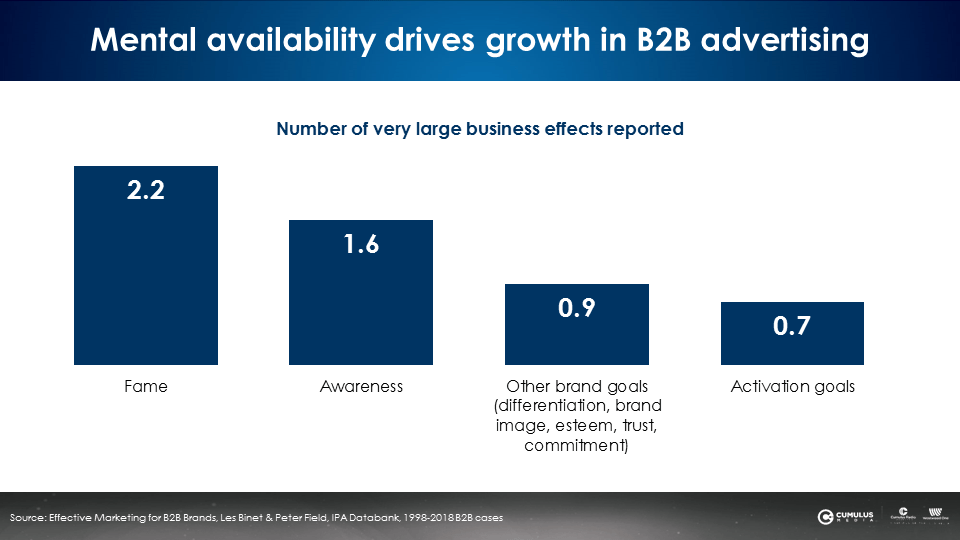
5. Harness the power of emotion in creative
Binet and Field have previously found that emotional campaigns build brands more strongly regardless of measure: awareness, commitment, trust, differentiation, fame, or image. Emotional creative generates strong bonds and associations for brands.
Looking at B2B cases, the same holds true. For branding campaigns, emotional campaigns are far more effective at delivering increased outcomes. For activation campaigns that highlight specific promotions or information, rational communication strategies work best.
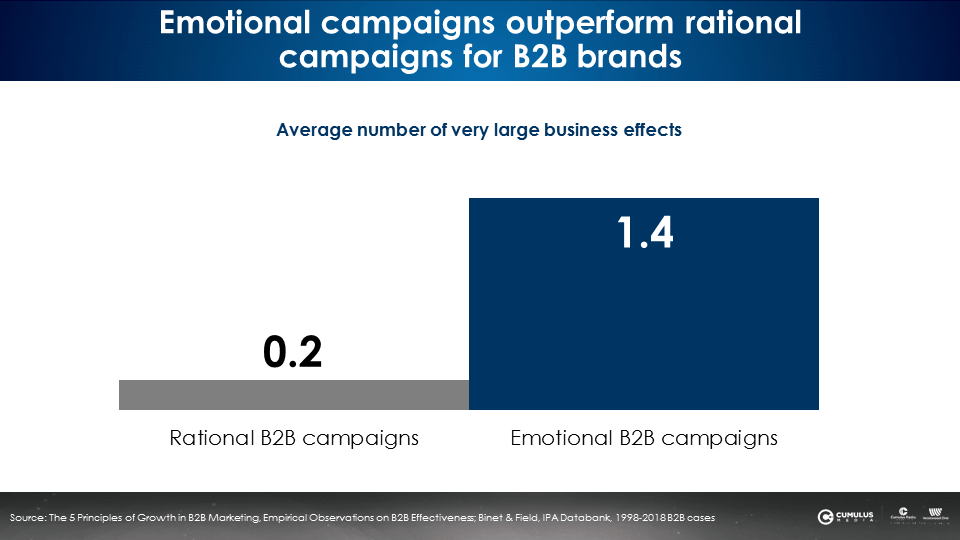
Binet and Field also found that fame and awareness strategies are more effective than differentiation campaigns that are based on factual information.
For B2B campaigns, appealing to emotions helps to humanize business-oriented topics. Binet and Field recommend appealing to emotional B2B themes by tailoring ad strategies and creative to the experience of this group:
- “We have the human touch in a tech-obsessed world
- We understand that it’s a tough world in business
- We empathize with the loneliness of the leader of a business
- Because we’re an obvious choice, we’re a safe choice for you
- We know the challenges of entrepreneurship, so we champion entrepreneurs
- Fear of missing out”
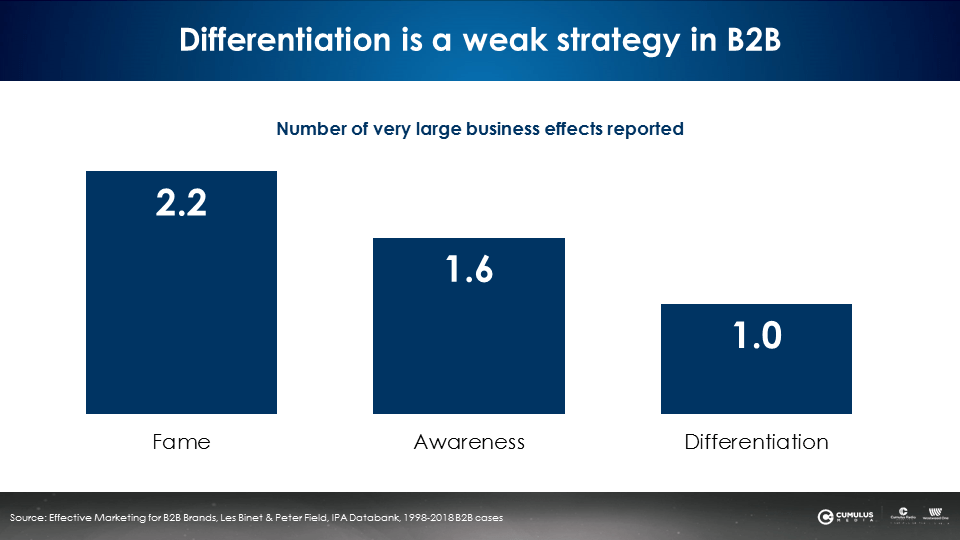
Today’s B2B marketing environment continues to grow with B2B marketers spending $108 billion annually, according to the Business Marketing Association. While no “one size fits all” marketing strategy exists for every B2B brand, Binet and Field’s five principles of growth provide an effective roadmap for B2B brands.
AM/FM radio is the ideal platform for B2B marketing. It has massive reach among business decision makers, impacts this important audience when they are a captive audience commuting in the car, and connects with them on an emotional and intellectual level. Business decision makers are also very similar in profile to frequent AM/FM radio listeners and tune in to a variety of programming formats.
Binet and Field’s five principles of growth for B2B advertisers:
- Invest in share of voice: To grow, insure your share of voice is greater than your market share
- Balance brand and activation: 62% branding, 38% sales activation
- Expand the customer base with mass reach media
- Maximize mental availability
- Harness the power of emotion in creative
Click here for more from The 5 Principles Of Growth in B2B Marketing from the B2B Institute
Pierre Bouvard is Chief Insights Officer at CUMULUS MEDIA | Westwood One.
Contact the Insights team at CorpMarketing@westwoodone.com.